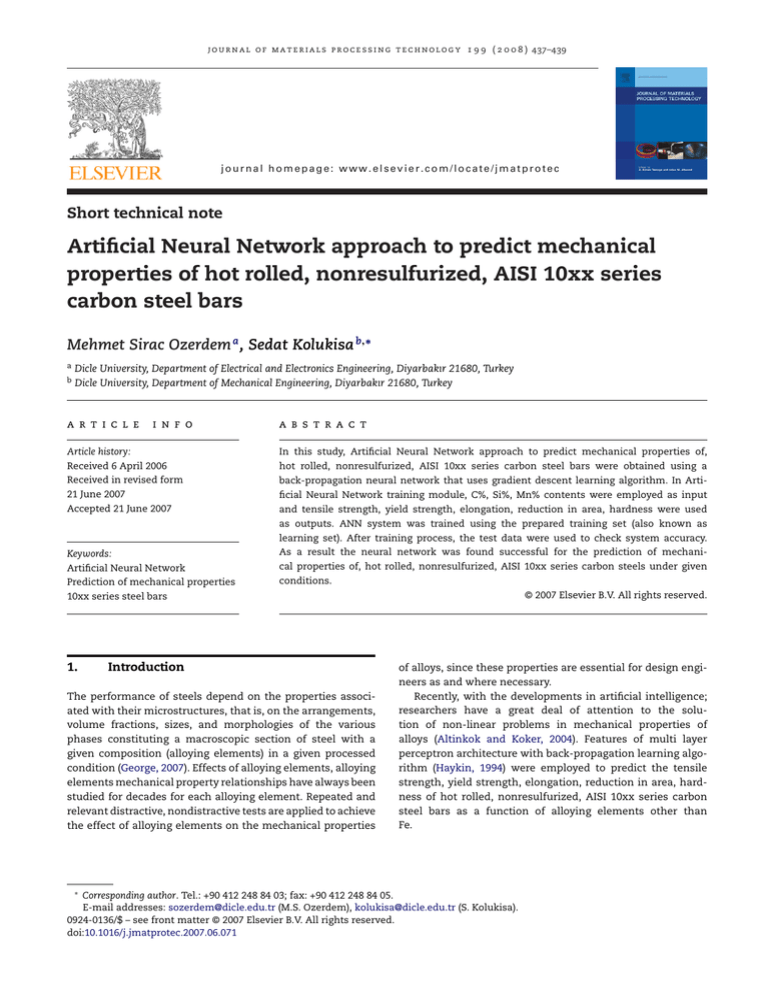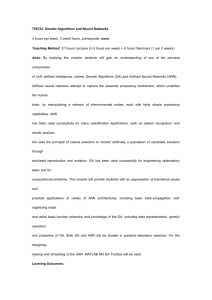
j o u r n a l o f m a t e r i a l s p r o c e s s i n g t e c h n o l o g y 1 9 9 ( 2 0 0 8 ) 437–439
journal homepage: www.elsevier.com/locate/jmatprotec
Short technical note
Artificial Neural Network approach to predict mechanical
properties of hot rolled, nonresulfurized, AISI 10xx series
carbon steel bars
Mehmet Sirac Ozerdem a , Sedat Kolukisa b,∗
a
b
Dicle University, Department of Electrical and Electronics Engineering, Diyarbakır 21680, Turkey
Dicle University, Department of Mechanical Engineering, Diyarbakır 21680, Turkey
a r t i c l e
i n f o
a b s t r a c t
Article history:
In this study, Artificial Neural Network approach to predict mechanical properties of,
Received 6 April 2006
hot rolled, nonresulfurized, AISI 10xx series carbon steel bars were obtained using a
Received in revised form
back-propagation neural network that uses gradient descent learning algorithm. In Arti-
21 June 2007
ficial Neural Network training module, C%, Si%, Mn% contents were employed as input
Accepted 21 June 2007
and tensile strength, yield strength, elongation, reduction in area, hardness were used
as outputs. ANN system was trained using the prepared training set (also known as
learning set). After training process, the test data were used to check system accuracy.
Keywords:
As a result the neural network was found successful for the prediction of mechani-
Artificial Neural Network
cal properties of, hot rolled, nonresulfurized, AISI 10xx series carbon steels under given
Prediction of mechanical properties
conditions.
© 2007 Elsevier B.V. All rights reserved.
10xx series steel bars
1.
Introduction
The performance of steels depend on the properties associated with their microstructures, that is, on the arrangements,
volume fractions, sizes, and morphologies of the various
phases constituting a macroscopic section of steel with a
given composition (alloying elements) in a given processed
condition (George, 2007). Effects of alloying elements, alloying
elements mechanical property relationships have always been
studied for decades for each alloying element. Repeated and
relevant distractive, nondistractive tests are applied to achieve
the effect of alloying elements on the mechanical properties
∗
of alloys, since these properties are essential for design engineers as and where necessary.
Recently, with the developments in artificial intelligence;
researchers have a great deal of attention to the solution of non-linear problems in mechanical properties of
alloys (Altinkok and Koker, 2004). Features of multi layer
perceptron architecture with back-propagation learning algorithm (Haykin, 1994) were employed to predict the tensile
strength, yield strength, elongation, reduction in area, hardness of hot rolled, nonresulfurized, AISI 10xx series carbon
steel bars as a function of alloying elements other than
Fe.
Corresponding author. Tel.: +90 412 248 84 03; fax: +90 412 248 84 05.
E-mail addresses: sozerdem@dicle.edu.tr (M.S. Ozerdem), kolukisa@dicle.edu.tr (S. Kolukisa).
0924-0136/$ – see front matter © 2007 Elsevier B.V. All rights reserved.
doi:10.1016/j.jmatprotec.2007.06.071
438
j o u r n a l o f m a t e r i a l s p r o c e s s i n g t e c h n o l o g y 1 9 9 ( 2 0 0 8 ) 437–439
2.
Artificial Neural Network (ANN)
approach and modeling data with network
An ANN is a mathematical model consisting of a number of highly interconnected processing elements organized
into layers, the geometry and functionality of which have
been likened to that of the human brain. The ANNs are
parallel process elements which has characteristic such as:
(a) ANN is a mathematical model of a biological neuron;
(b) ANN has various process elements which are related
to each other; (c) ANN keeps knowledge with connection
weights.
The network has one input layer, one hidden layer and
one output layer. The input layer consists of all the input factors. Information from the input layer is then processed in the
course of one hidden layer, following output vector is computed in the final (output) layer. A schematic description of
the layers is given in Fig. 1. In developing an ANN model, the
available data set is divided into two sets, one to be used for
training of the network, and the remaining is to be used to verify the generalization capability of the network (Haykin, 1999).
Input–output pairs are presented to the network and weights
are adjusted to minimize the error between the network output and actual value.
Among the various kinds of ANN approaches that exit,
the multi layer perceptron (MLP) architecture with backpropagation learning algorithm has become the most popular
in engineering applications (Okuyucu et al., 2007; Song et al.,
2005). Back-propagation algorithm, which is common in literature, has been used to update the forward path parameters in
ANNs. This method is based on minimization of the quadratic
cost function by tuning the network parameters. The mean
square error is considered as a measurement criterion for a
training set.
Fig. 1 – The structure of three-layered neural network in
present study.
3.
Experimental procedures
3.1.
Collecting the experimental data
The chemical compositions and the mechanical properties
of hot rolled, nonresulfurized, AISI 10xx series carbon steel
bars were collected from related standards and CASTI metals
black book—North American Ferrous Data, steel manufacturers (CASTI).
3.2.
Working platform
MATLAB platform was used to train and test the ANN. In the
training, increased number of neurons (8–12) in the hidden
layer has been used in order to define the output accurately.
After training the network successfully, it has been tested by
using the known data. Statistical methods were used to compare the results produced by the network. Errors occurring
at the learning and testing stages are called the root-mean
squared (RMS), absolute fraction of variance (R2 ), and mean
percentage error (MPE) values.
4.
Evaluation of results and discussions
The aim of employing an ANN model is to predict the mechanical properties of hot rolled, nonresulfurized, AISI 10xx series,
carbon steel bars. The network has three input parameters:
C, Mn and Si contents and five output parameters: tensile
strength, yield strength, elongation, reduction in area and
hardness. So, the architecture of ANN becomes 3-10-5, 3 corresponding to the input values, 10 to the number of hidden
layer neurons and 5 to the outputs.
The experimental data set includes 44 patterns, of which
33 patterns were used for training the network and 11 patterns were selected randomly to test the performance of the
trained network. All the input and output values were normalized between 0.1 and 0.9 by using linear scaling. The
log-sigmoid transfer function was used in the hidden and
output layer. During the training period, the averaged square
error decreased with increasing number of iteration. After
5000 training cycles, significant effect on error reduction has
not been traced. The performance changing of ANN in training
stage is given in Fig. 2.
With the increasing number of reliable input data,
improves the integrity of the training session and target outputs. Comparison of measured and predicted mechanical
properties (tensile strength, yield strength, elongation, reduction in area and hardness) at training and testing stages
indicated that there is a high correlation between them.
The decision as to the number of neurons used in the hidden layer usually depends on the arithmetical mean of the
number of inputs and outputs. In this application 8–12 hidden
layers were employed to test. The algorithm with 10 hidden
layer neurons is suggested to be used in present application.
Statistical values of tensile strength, yield strength, elongation, reduction in area and hardness were presented in Table 1.
As a result of statistical values namely, root-mean squared
(RMS), absolute fraction of variance (R2 ) and mean percent-
ID
791782
Title
ArtificialNeuralNetworkapproachtopredictmechanicalpropertiesofhotrolled,nonresulfurized,AISI
10xxseriescarbonsteelbars
http://fulltext.study/article/791782
http://FullText.Study
Pages
3



